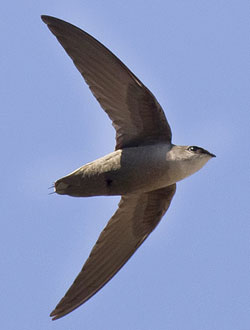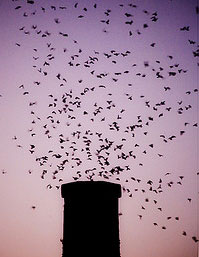Chimney Swifts
Chaetura pelagica
 Description & Range:
Description & Range:
The Chimney Swift is a small bird with a slender body and very long, narrow, curved wings. They have small round heads, short necks, and short, tapered bill. They can grow to sizes of 5.9 inches in length with an 11.8 inch wingspan and can weigh up to 1.1 ounces. Chimney Swifts are dark-gray brown all over with lighter plumage on their neck. Chimney Swifts have specially designed feet that enable them to cling to vertical surfaces.
Their summer breeding range consists of the mid-eastern United States and southern Canada. In early spring and late fall, Chimney Swifts can be seen migrating through Maryland by the thousands. Some Chimney Swifts remain here to breed while others continue their journey to other parts of the eastern United States and Canada. Chimney Swifts overwinter in South America.
Habitat:
Chimney Swifts are most common in areas with a large abundance of porous vertical surfaces for nest sites and roosts such as brick or concrete overhangs, bridges, and chimneys for which they take their common name. In rural areas, they may nest in hollow trees or caves. Chimney Swifts use open areas for foraging but also may forage in forests, over ponds, or in residential areas. During migration, they can be found in large flocks foraging over open areas or forests.
Diet:
Chimney Swifts feed on flying insects including flies, mosquitos, beetles, wasps, bees, and other insects. Chimney Swifts feed in open fields, forests, or shrublands, usually away from their nest sites. They are noted for their ability to flush out insects by flying low and using the air pressure from concentrated downdrafts to disturb potential prey.
Reproduction:
Chimney Swifts perform aerial courtship displays within 2 weeks of arriving to their North American breeding grounds. In one of the most well known courship displays, the two birds fly close together while calling. The rear bird and then the leader will snap its wings into a V-shape and the two glide together in a downward curve. Once the breeding pair is formed, they are monogomous throughout the breeding season.
Both members of a breeding pair will scout out several potential nest locations. Once a suitable nest is found, the pair willcling side by side onto the final nest site, with one member of the pair giving a rhythmic chipping call. Nests are built into a half saucer shape from loosely woven twigs. The nests are attached to vertical surfaces with the birds glue-like saliva. Both parents contribute to the construction of the nest. Nests, on average, measure 2-3 inches long, 4 inches wide, and an inch deep.
Females normally lay 3-5 white eggs that are incubated by alternating adults for 18-19 days. After hatching, both parents alternate catching insects for their young. Hatchlings are pink and completely naked at birth with sharp claws that enable them to cling to textured surfaces. Within a few days, black pin feathers begin to appear. Once they are 8-10 days of age, the nestling’s feathers begin to unfurl. By 15-17 days of age, their eyes begin to open and most of the flight and body feathers will be unfurled. Close to a month after hatching, young Chimney Swifts will leave the nest for their first flight. Young will return to the nest site for a few days but will eventually begin their adult life after being pushed out by their parents.
Sounds:
Chimney Swifts make a loud, rapid ticking or twittering of high pitched chip notes about 3 seconds long.
 Behavior:
Behavior:
Chimney Swifts spend the majority of their lives in the air, only stopping to roost or to nest. Solitary birds will roost together in large flocks. Often, an unmated individual may assist a breeding pair with rearing the young. After the breeding season, Chimney Swifts join larger flocks to migrate to South America. During migration, as many as 10,000 swifts may circle in a tornado-like flock at dusk and funnel into a roosting colony to spend the night. The lives of these widespread urban adapted birds are surprisingly unstudied due to their inaccessible nesting and roosting sites and their aerial lifestyle.
Conservation
The Chimney Swift has been in a constant decline in population of about 2.2% since 1966. When European settler began arriving and building millions of chimneys, the Chimney Swift population grew abundantly. Today, with new chimney designs and the destruction of old growth forests, the natural nesting and roosting sites for the Chimney Swift are declining. Partners in Flight documents a 67% population decline in Chimney Swifts from 1970-2014.
The Chimney Swift Conservation Program, through the Maryland Bird Conservation Partnership, seeks to assess local Chimney Swift populations as well as increase nesting areas for local birds. To help local Chimney Swifts, consider helping with the program through reporting active chimney/tower sites, providing homes for Chimney Swifts, and/or volunteering for the program. For more information, please visit: https://marylandbirds.org/chimney-swifts
Click here to learn more about what to do if Chimney Swifts inhabit your residence or to learn about how to create an artificial chimney swift nesting structure.
Did You Know?
Chimney Swifts are incapable of perching like most birds. Their long claws are suited only for clinging to the walls of vertical surfaces.
Photo Credits:
Chimney Swift in flight, courtesy of Thompson Rivers University
Chimney Swift flock circling into roosting site, courtesy of Steve Benoit